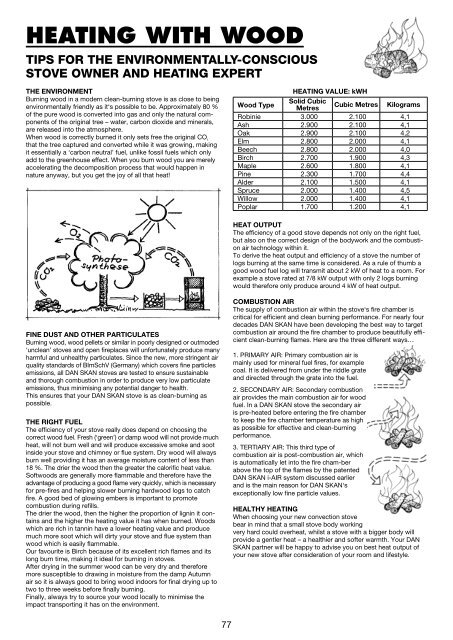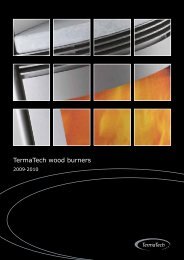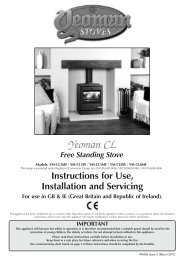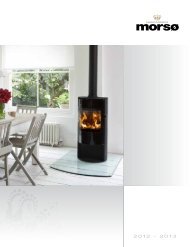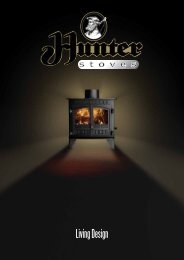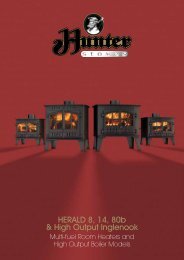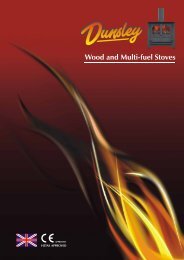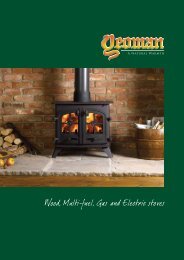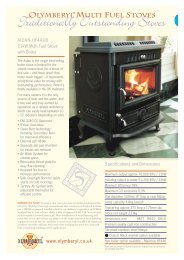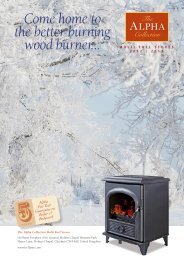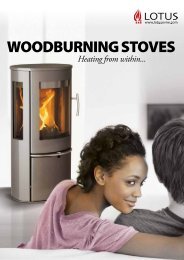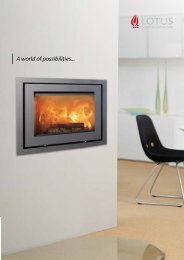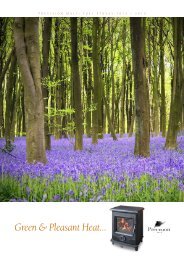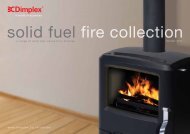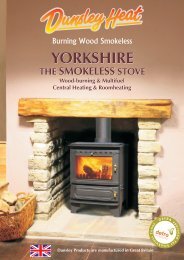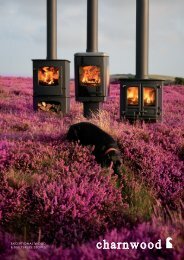Create successful ePaper yourself
Turn your PDF publications into a flip-book with our unique Google optimized e-Paper software.
HEATING WITH WOOD<br />
TIPS FOR THE ENVIRONMENTALLY-CONSCIOUS<br />
<strong>STOVE</strong> OWNER AND HEATING EXPERT<br />
THE ENVIRONMENT<br />
Burning wood in a modern clean-burning stove is as close to being<br />
environmentally friendly as it‘s possible to be. approximately 80 %<br />
of the pure wood is converted into gas and only the natural components<br />
of the original tree – water, carbon dioxide and minerals,<br />
are released into the atmosphere.<br />
When wood is correctly burned it only sets free the original CO ²<br />
that the tree captured and converted while it was growing, making<br />
it essentially a ‘carbon neutral’ fuel, unlike fossil fuels which only<br />
add to the greenhouse effect. When you burn wood you are merely<br />
accelerating the decomposition process that would happen in<br />
nature anyway, but you get the joy of all that heat!<br />
FINE DUST AND OTHER PARTICULATES<br />
Burning wood, wood pellets or similar in poorly designed or outmoded<br />
‘unclean’ stoves and open fireplaces will unfortunately produce many<br />
harmful and unhealthy particulates. Since the new, more stringent air<br />
quality standards of BimSchV (germany) which covers fine particles<br />
emissions, all Dan SKan stoves are tested to ensure sustainable<br />
and thorough combustion in order to produce very low particulate<br />
emissions, thus minimising any potential danger to health.<br />
This ensures that your Dan SKan stove is as clean-burning as<br />
possible.<br />
THE RIGHT FUEL<br />
<strong>The</strong> efficiency of your stove really does depend on choosing the<br />
correct wood fuel. Fresh (‘green’) or damp wood will not provide much<br />
heat, will not burn well and will produce excessive smoke and soot<br />
inside your stove and chimney or flue system. Dry wood will always<br />
burn well providing it has an average moisture content of less than<br />
18 %. <strong>The</strong> drier the wood then the greater the calorific heat value.<br />
Softwoods are generally more flammable and therefore have the<br />
advantage of producing a good flame very quickly, which is necessary<br />
for pre-fires and helping slower burning hardwood logs to catch<br />
fire. a good bed of glowing embers is important to promote<br />
combustion during refills.<br />
<strong>The</strong> drier the wood, then the higher the proportion of lignin it contains<br />
and the higher the heating value it has when burned. Woods<br />
which are rich in tannin have a lower heating value and produce<br />
much more soot which will dirty your stove and flue system than<br />
wood which is easily flammable.<br />
Our favourite is Birch because of its excellent rich flames and its<br />
long burn time, making it ideal for burning in stoves.<br />
after drying in the summer wood can be very dry and therefore<br />
more susceptible to drawing in moisture from the damp autumn<br />
air so it is always good to bring wood indoors for final drying up to<br />
two to three weeks before finally burning.<br />
Finally, always try to source your wood locally to minimise the<br />
impact transporting it has on the environment.<br />
77<br />
HEATING VALUE: kWH<br />
Wood Type<br />
Solid Cubic<br />
Metres<br />
Cubic Metres Kilograms<br />
robinie 3.000 2.100 4,1<br />
ash 2.900 2.100 4,1<br />
Oak 2.900 2.100 4,2<br />
Elm 2.800 2.000 4,1<br />
Beech 2.800 2.000 4,0<br />
Birch 2.700 1.900 4,3<br />
Maple 2.600 1.800 4,1<br />
Pine 2.300 1.700 4,4<br />
alder 2.100 1.500 4,1<br />
Spruce 2.000 1.400 4,5<br />
Willow 2.000 1.400 4,1<br />
Poplar 1.700 1.200 4,1<br />
HEAT OUTPUT<br />
<strong>The</strong> efficiency of a good stove depends not only on the right fuel,<br />
but also on the correct design of the bodywork and the combustion<br />
air technology within it.<br />
To derive the heat output and efficiency of a stove the number of<br />
logs burning at the same time is considered. as a rule of thumb a<br />
good wood fuel log will transmit about 2 kW of heat to a room. For<br />
example a stove rated at 7/8 kW output with only 2 logs burning<br />
would therefore only produce around 4 kW of heat output.<br />
COMBUSTION AIR<br />
<strong>The</strong> supply of combustion air within the stove‘s fire chamber is<br />
critical for efficient and clean burning performance. For nearly four<br />
decades Dan SKan have been developing the best way to target<br />
combustion air around the fire chamber to produce beautifully efficient<br />
clean-burning flames. Here are the three different ways…<br />
1. PriMarY air: Primary combustion air is<br />
mainly used for mineral fuel fires, for example<br />
coal. it is delivered from under the riddle grate<br />
and directed through the grate into the fuel.<br />
2. SECOnDarY air: Secondary combustion<br />
air provides the main combustion air for wood<br />
fuel. in a Dan SKan stove the secondary air<br />
is pre-heated before entering the fire chamber<br />
to keep the fire chamber temperature as high<br />
as possible for effective and clean-burning<br />
performance.<br />
3. TErTiarY air: This third type of<br />
combustion air is post-combustion air, which<br />
is automatically let into the fire cham-ber<br />
above the top of the flames by the patented<br />
Dan SKan i-air system discussed earlier<br />
and is the main reason for Dan SKan‘s<br />
exceptionally low fine particle values.<br />
HEALTHY HEATING<br />
When choosing your new convection stove<br />
bear in mind that a small stove body working<br />
very hard could overheat, whilst a stove with a bigger body will<br />
provide a gentler heat – a healthier and softer warmth. Your Dan<br />
SKan partner will be happy to advise you on best heat output of<br />
your new stove after consideration of your room and lifestyle.


